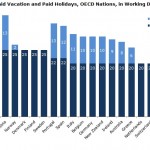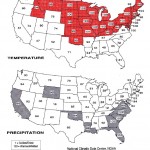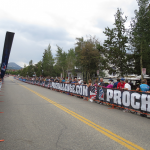The RRC Associates May newsletter is out!
Unused Vacation Days
 It’s hard to believe, but many U.S. workers don’t use all their vacation time – and lose that benefit at the end of the year. I know what you’re probably thinking: “I’ll take some of those vacation days!”
It’s hard to believe, but many U.S. workers don’t use all their vacation time – and lose that benefit at the end of the year. I know what you’re probably thinking: “I’ll take some of those vacation days!”
Estimates of the total unused vacation days vary from 175 million to 429 million days annually.
Not only do U.S. workers not use all their vacation days, but the U.S. is the only developed country that does not mandate any paid vacation or paid holiday days. While 90 percent of full-time American workers are granted vacation time as part of their compensation package, there is no doubt that our country is the stingiest when it comes to time off.
Why don’t American workers use all the vacation time that they are entitled to? Apparently a mix of workplace and self-imposed pressures. Almost four in ten say they have too much work to do. Many employees also feel dedicated to their work and the needs of their employer, while some employees say that company culture discourages taking time off. Personal issues such as a challenges in coordinating vacation schedules with family and friends, an inability to afford travel, and a desire to make more money are also a factor for some employees.
Tourism-based businesses that rely on people taking vacations would be well-served to consider ways to position vacation time as beneficial – providing opportunities to enhance work-life balance, enjoy time with family or friends, rest and recharge, and return to work more productive. These messages, among others, might help to counter the trend of unused vacation days – and indeed are the thrust of the U.S. Travel Association’s “Travel Effect” initiative. After all, unused vacation days don’t come back.
Predictions of an El Niño Winter
 The Jason-2 satellite, which monitors changes in sea surface height (an indicator of upper layer water temperatures), has recently generated a new prediction regarding global forecasts of weather and climate. Based on a series of Kelvin waves monitored by the satellite, NOAA has recently issued an El Niño Watch. According to NASA climatologist Bill Patzert, “A pattern of sea surface heights and temperatures has formed that reminds me of the way the Pacific looked in the spring of 1997.”
The Jason-2 satellite, which monitors changes in sea surface height (an indicator of upper layer water temperatures), has recently generated a new prediction regarding global forecasts of weather and climate. Based on a series of Kelvin waves monitored by the satellite, NOAA has recently issued an El Niño Watch. According to NASA climatologist Bill Patzert, “A pattern of sea surface heights and temperatures has formed that reminds me of the way the Pacific looked in the spring of 1997.”
El Niño events have occurred most recently in 2009, 2006/07, and 2002/03. However, the 1997/98 El Niño was the strongest ever recorded. According to the U.S. National Climatic Data Center, 1997/98 was the second warmest and seventh wettest winter since 1895. The following states experienced some of their wettest weather on record: California, North Dakota, Florida, Maryland, Nevada, Rhode Island, and Virginia.
What does this mean for the 2014/15 winter season? It might be another two to three months before we know if recorded weather patterns are indicative of a major El Niño (or any El Niño at all). However, if the El Niño predictions materialize, we might expect to see regional variations similar to 1997/98. As tracked in Kottke National End of Season Survey for 1997/98, the Northeast and Pacific West clearly benefited from El Niño’s effects, as did the Rockies, which set a new visitation record. Conversely, the Southeast and Midwest both had below-average seasons. Considerable local variation occurred within each region.
Summer Sporting Events Research
Memorial Day weekend marked the unofficial start of summer, which in the Intermountain West means a plethora of sporting and recreational events to enjoy, either as a participant or spectator. Events across the region play a role in driving tourism and economic development, generating media visibility, and providing destination marketing and branding opportunities.
RRC is hitting the course this summer, conducting research for the following sporting events:
 Pro Challenge: The Colorado-grown cycling race will be back for its fourth season August 18th – 24th. Again, the course will take cyclists through a mix of mountain and urban destinations. This year, the race will come to Boulder for the second time, as the start for the final Stage 7 (Boulder to Denver). RRC will be using our developed attendance-counting methods, intercept survey instruments and a media audit to assess the economic impact of the Boulder stage.
Pro Challenge: The Colorado-grown cycling race will be back for its fourth season August 18th – 24th. Again, the course will take cyclists through a mix of mountain and urban destinations. This year, the race will come to Boulder for the second time, as the start for the final Stage 7 (Boulder to Denver). RRC will be using our developed attendance-counting methods, intercept survey instruments and a media audit to assess the economic impact of the Boulder stage.
Ogden Marathon: As part of a special events study for Ogden, Utah, RRC is assessing the impact of several events throughout the summer. The Ogden Marathon, which occurred May 17, was the first event as part of this research program. The next event is Cannondale, taking place June 20-27.
IRONMAN Boulder: Boulder has become a Mecca for triathletes. This summer Boulder hosts its first full IRONMAN on August 3. Participants will swim 2.4 miles, bike 112 miles, and run a full marathon. How many spectators will be in attendance? What will be the economic impact of the event? How will locals and visitors feel about the event? RRC intends to answer these questions, among others, in a study commissioned by the Boulder Convention and Visitors Bureau.
From the Data Desk
RRC recently conducted a National Summer Survey of Ski Resort Operators on behalf of NSAA. Over 100 resorts from across the country participated in the summer survey, 84 percent of which currently have summer operations.
Resorts with summer operations currently offer a wide range of activities, with the top and bottom five offerings highlighted below.
Top 5 offerings
-Weddings/meetings/family reunions (offered by 81 percent of participating resorts with summer operations)
-Scenic lift rides (68 percent)
-Hiking (68 percent)
-Festivals/concerts (53 percent)
-Mountain biking (50 percent)
Bottom 5 offerings
-Water park (9 percent)
-Climbing wall (9 percent)
-Mountain coaster (8 percent)
-Mini golf (4 percent)
-Geocaching (1 percent)
Which activities and amenities are most successful? Resorts rated the financial success of their amenities using a 10-point scale, where 1 meant “Not at all successful” and 10 meant “Extremely successful.” The results show a clear demarcation between winners and losers
Alpine slide (9.1), water park (8.8), and mountain coaster (8.7) received the highest average ratings of financial success. Meanwhile, geocaching (4.2), disc golf (4.3), and mountain biking (4.5) brought up the rear.
Note that mountain biking is an interesting example of an activity that is being widely offered at mountain resorts, but in some cases financial performance is not particularly successful. Conversely, water parks and mountain coasters are less common amenities, but have a high average rating of financial success.
RRC has conducted a much deeper analysis of summer events than is summarized here, both in terms of participation profiles and return on investment. Many of these results were reported at the NSAA conference in Savannah. Please feel free to contact us for further information on summer-related data and research.
What are we up to?
Conferences
Keep an eye out for representatives from RRC, who will be attending and speaking at the following conferences:
Quebec Ski Areas Association Annual Convention and Tradeshow, May 27 to 29, 2014
Colorado Ski Country USA Annual Meeting, Copper Mountain, CO, June 12, 2014
RRC On-Snow Activities in 2013/14
Believing in the power of data and accurate records, we at RRC track our collective skiing/riding visits on a weekly basis. 2013/14 was a record season for RRC, with a total of 167 downhill days and 53 cross-country or backcountry days. Two of our staff logged 50+ days – and some of us are still planning to enjoy more summer corn!
Recent Press Coverage
-RRC has helped many communities create programs to track and evaluate the economic contribution of events. A recent study for Vail, featured in Mountain Town News, evaluated summer and winter events using a variety of measures. Such studies continue to advance the understanding of the contributions events can provide, and also equip decision-makers with expanded tools to evaluate event performance.
-RRC’s Director of Consulting Services, Dave Belin, was recently featured in a Denver Post article that recapped 2013/14 lodging revenue and visitation.
-The American Planning Association County Planning Division and its sister organization, the National Association of County Planners, has bestowed the Award of Excellence to “Our Lands – Our Future: Recreation & Conservation Choices for Northern Colorado,” a conservation study in the Grass Roots Initiative category. For the first time in Colorado, all of the local governments in a county engaged in a comprehensive study on land conservation and nature-based recreation to evaluate successes, potential improvements, and existing gaps. The regional conservation study used extensive public outreach, an interactive GIS website, and dedicated engagement by nine partner agencies to produce a plan that shapes the vision of open space conservation in Larimer County. RRC teamed with Logan Simpson Design and a number of others firms on this very successful study.
